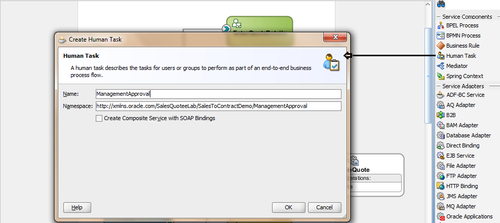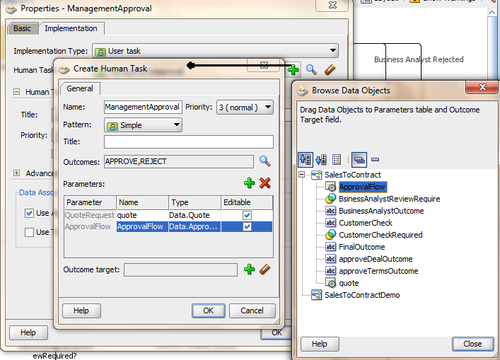You created Human Task Service Components while you were creating Human Tasks for User tasks in your BPM process SalesToContract. However, here you will revise the method you have adopted and change how Service Components are formed and associated with the BPM process.
You can create Human Task Service Components in either the SOA Composite editor or in BPM Designer as follows:
I. Creating a Human Service Component in SOA Composite Editor:
- Start Oracle JDeveloper in the default role (to enable all technologies) and go to the project
SalesToContractDemo. - Click on
composite.xmlto open the Composite Editor. - Go to Component Palette |SOA | Service Component and drag-and-drop Human Task Service Components in the Composite designer, where required.
- This will open the Human Task dialog. Give a Name to the Human Task. This will be created as a task file in the project.

- Don't check the Create Composite Service with SOAP Bindings as you want this Human Task Service Component to be associated later with the BPM process.
- This will create a Human Task, ManagementApproval, which you can associate with the BPM process later.
Note
Clicking the Create Composite Service with SOAP Bindings checkbox will create a standalone component in the composite editor and a Human Task Service Component that is automatically wired to a Simple Object Access Protocol (SOAP) web service. This may be required in case we need to expose Human Task services as web services that are to be invoked by clients like OSB and so on.
- When you have finished, click Save.
II. Creating a Human Service Component in BPM Process Designer:
The following method is the one you have followed while creating a Human Task in a BPM process.
- Click on Activities in the component palette and click User task.
- Click on the salesrepresentative swimlane to the right of the Check customer rule.
- In the User Task properties, enter your name as ManagementApproval and click OK.
- You will implement this task in the following section of this chapter.
Note
Remember in Chapter 4, Business Rules in the BPM Process, in the Adding Gateway and Human Task section, you have the Model Management Approval Task in a BPM process.
- Right-click on the User task Management Approval and go to the Implementation tab.
- Click on the green plus (+) icon to create a Human Task and enter details, as shown in the following screenshot:

- Click on the green plus (+) icon next to Parameters to add Input Parameters to the Human Task.
- From Browse Data Objects, choose ApprovalFlow and Data objects quote as Input parameters.
- This will create a ManagementApproval task which you can verify from BPM Navigator | SalesToContractDemo | Business Catalog | Human Tasks.
- When you have finished, click Save.
When a Human Task is created, the Human Task settings specified in the Human Task editor are saved to a metadata task configuration file in the Metadata Service (MDS) repository with a .task extension. This file appears in Application Navigator | SOAProjectName | SOA Content or BPM Navigator | SalesToContractDemo | BusinessCatalog | HumanTasks. You can re-edit the settings in this file by double-clicking .task in either of those places.
Clicking on the .task file will open the Human Task editor that has many sections, which are described as follows:
- General section: This is used to define task details such as the title, task outcomes, the owner, and other attributes.
- Data section: This defines the structure (message elements) of the task payload (the data in the task).
- Assignment section: This will enable you to assign participants to the task and create a policy for routing the task through the workflow.
- Presentation section: This enables you to specify Multilingual settings while the Deadlines section enables you to specify the expiration duration of a task, custom escalation Java classes, and due dates.
- Notification section: This section will enable you to create and send notifications when a user is assigned a task or informed that the status of the task has changed.
- Access section: This section will enable you to specify access rules for the task content and task actions, workflow signature policies, and assignment restrictions.
- Events section: This section enables you to specify call-back classes and task and routing assignments. Worklist events leverage the inbuilt EDN engine to publish status changes for a task example on completion, and so on.

